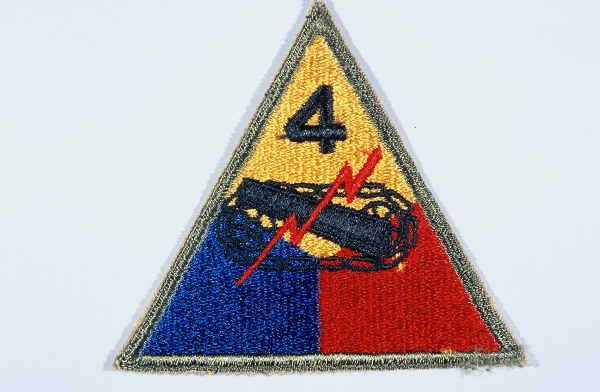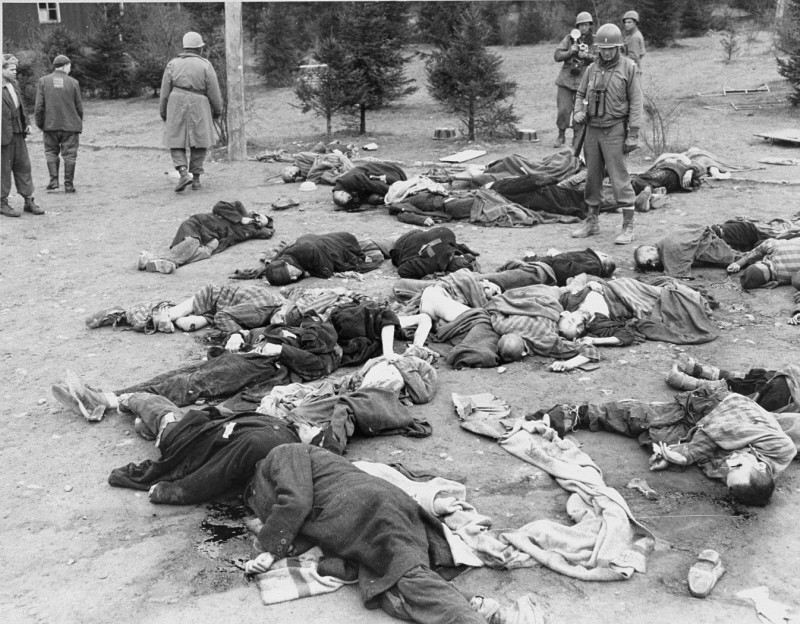
The 4th Armored Division during World War II
In 1985, the United States Holocaust Memorial Museum and the US Army Center of Military History began a program to honor US Army divisions that took part in the Allied liberation of Nazi camps. The US Army Center of Military History defines a liberating division as one whose official records show its presence at a camp within 48 hours of the first soldier’s arrival. The 4th Armored Division is among the 36 US divisions that have been recognized to date.
Key Facts
-
1
US, British, Soviet, and Canadian troops encountered concentration camps and other sites of Nazi crimes as they advanced across Europe in 1944 and 1945.
-
2
The Allied soldiers liberated sick and starving camp prisoners from Nazi tyranny. They also provided them with food, clothing, and medical aid.
-
3
The United States Holocaust Memorial Museum and the US Army Center of Military History have recognized 36 US divisions for their role in the liberation of Nazi camps.
4th Armored Division Campaigns during World War II
The 4th Armored Division was established on April 15, 1941. It landed at Utah Beach on July 13, 1944, just over a month after the D-Day invasion (June 6, 1944) of the French Normandy coast. Within weeks, the so-called "Breakthrough" division was sweeping across France. During the Battle of the Bulge, the division provided badly needed support to the surrounded US forces in Bastogne, Belgium. In late March 1945, the 4th crossed the Rhine River into central Germany. By war’s end, the 4th Armored Division reached the Czech border.
The 4th Armored Division and the Liberation of Ohrdruf
On April 4, 1945, the "Breakthrough" division overran Ohrdruf, a subcamp of the Buchenwald concentration camp. It was the first Nazi camp liberated by US troops.
The SS established the Ohrdruf subcamp in November 1944 near the town of Gotha. At its peak in late March 1945, the camp had a prisoner population around 11,700. The SS forced prisoners to construct railway lines and dig large caverns inside a nearby mountain for the construction of a new communications center. This communications center, however, was never completed because of the rapid US advance. Conditions at the work site were harsh, unsafe, and unhealthy. As the Allies approached in early April 1945, the SS moved thousands of prisoners from Ohrdruf on foot and in trucks to the Buchenwald main camp and toward Regensburg. Prisoners who were too ill to walk to the railway cars were killed by SS guards.

When American soldiers entered the camp, they discovered the decomposing remains of hundreds of murdered prisoners. Some bodies were covered with lime. Others were partially incinerated. The soldiers also encountered starving and emaciated survivors in need of medical attention.
On April 12, 1945, a week after the camp’s liberation, Dwight D. Eisenhower visited Ohrdruf. Eisenhower was Supreme Commander of the Allied Expeditionary Forces in Europe at the time. Generals Omar Bradley and George S. Patton accompanied him. The evidence of Nazi atrocities at the camp shocked the US Army leadership. After this visit, Eisenhower contacted General George C. Marshall, who was chief of staff of the US Army and a member of the Joint Chiefs of Staff since 1942. Eisenhower urged Marshall to send Congressional delegations and prominent US newspaper editors to tour the newly liberated Nazi camps.
The 4th Armored Division's discovery of the Ohrdruf subcamp opened the eyes of many US soldiers to the horrors committed by the Nazis during the Holocaust.
Recognition as a Liberating Division
The US Army's Center of Military History and the United States Holocaust Memorial Museum recognized the 4th Armored Division as a liberating unit in 1985.
4th Armored Division Battle Casualty Figures
Hundreds of thousands of US servicemen and women died or were wounded in the fight against Nazi tyranny.
The total number of battle casualties for the 4th Armored Division in the European Theater of Operations during World War II was 6,212. In this case, “battle casualties” includes all personnel who were unable to fight in battle because they were wounded, missing, captured, or killed.
Among the battle casualties suffered by the 4th Armored Division, there were 1,366 deaths.
4th Armored Division Nickname and Insignia
The first commanding general of the 4th Armored Division was Major General John Shirley Wood. He refused to sanction an official nickname for the 4th. He believed that the division's accomplishments on the battlefield made one unnecessary. “They shall be known,” he said, “by their deeds alone.” For this reason, the division unofficially became known as the “Name Enough” division. It was also occasionally referred to as the "Breakthrough" division because of its role in the breakout from the Normandy beachhead and liberation of France in 1944.
The patch or insignia of the 4th Armored Division is shaped like a pyramid and represents power. In the center of the patch are three intertwined symbols in black: a tank tread, a cannon, and a lightning bolt. The tank tread symbolizes mobility. The cannon represents firepower. And the lightning bolt stands for shock action (a quick, offensive, military attack that surprises the enemy). The three symbols are placed against a tricolored background comprised of yellow, red, and blue. These colors represent key components of an armored division: cavalry (yellow), field artillery (red), and infantry (blue). The division number appears in black near the top of the pyramid (against the yellow part of the patch).

Footnotes
-
Footnote reference1.
In the aftermath of World War II, the US Department of the Army compiled casualty figures for US Army personnel. The US government published these figures in 1953. The report listed casualty numbers for the US Army for the period from December 7, 1941 (Pearl Harbor) through December 31, 1946, when US President Harry S. Truman officially declared the end of war hostilities. Army Battle Casualties and Nonbattle Deaths: Final Report, 7 December 1941-31 December 1946, Prepared by the Statistical and Accounting Branch, Office of the Adjutant General, Under the Direction of the Program Review and Analysis, Division of the Comptroller of the Army, O.C.S., (Washington: Department of the Army, 1953), p. 3-4, 84-89.
-
Footnote reference2.
See Don M. Fox, Patton’s Vanguard: The United States Army Fourth Armored Division, (Jefferson, NC and London: MCFarland & Company, Inc., Publishers, 2003), 9.
Critical Thinking Questions
What challenges did Allied forces face when they encountered the camps and sites of other atrocities?
What challenges faced survivors of the Holocaust upon liberation?

